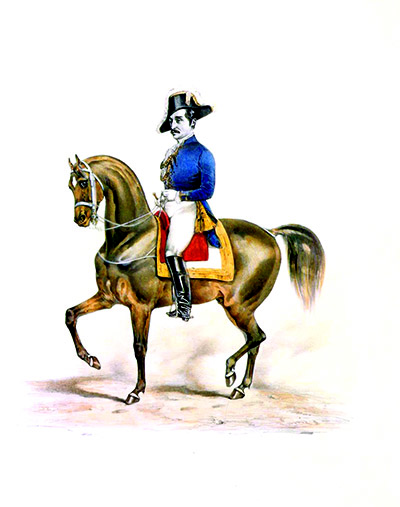
By Christopher Hector
For all the talk of a classical tradition extend back hundreds (some even say, thousands) of years, really dressage as we know it really started to flower only in the latter half of the nineteenth century…
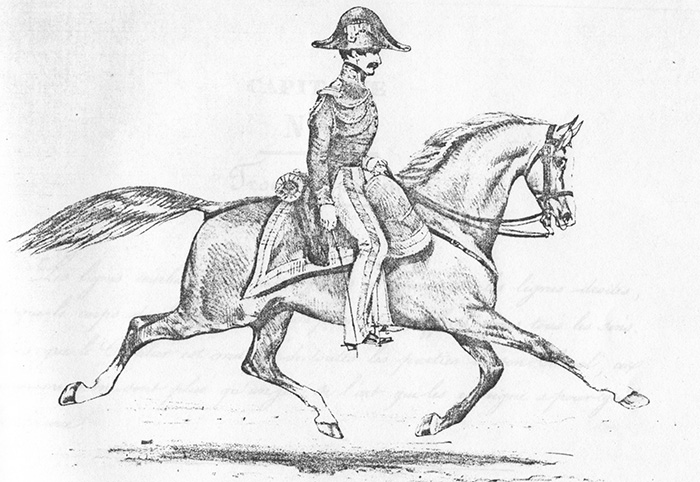
The first engraving I can find of a horse in extended trot is this one of Baucher – very much a child of the nineteenth century, and to find the next step in the development of the classical tradition, a step that sees the outline of the horse change from a fixed contained never varying outline, to a concertina, with the horse’s frame moving longer and shorter in keeping with the demands of the movement, we must turn to the nineteenth century German master, Gustav Steinbrecht and his work, The Gymnasium of the Horse.
In his preface to the 1935 edition of Gymnasium the great German showjumping rider, Col. H. H. Brinkmann clearly lines up the equestrian principles outlined with the physical properties of the horse, and this is the crucial aspect of the classical way, it is based on, and responsive, to the physical properties of the horse:
“Thus we confirm the accuracy of the thesis that even future discoveries will be unable to change Steinbrecht’s system because its principles have been gleaned from nature.”
Steinbrecht was an advocate of the English saddle, not just for hunting and steeplechase but also for dressage riding, because it demanded a balanced seat on the part of the rider:
“While the old masters, on their dressage saddles knew how to advance the art of riding to a high level under greater expenditures of time and strength on the part of horse and rider, we, if we reach the same level with our lighter, more agile, and nobler horses, will have produced a more perfect art since we have attained this goal with nothing but simple, natural means.”
(Page 6 of the Xenophon Edition – how indebted we all are to Ivan Berzugloff not only for his splendid magazine, Dressage & CT, and his excellent Xenophon classics…)
Along with the change of saddles, came a change of seat, or there should be a change, according to Steinbrecht:
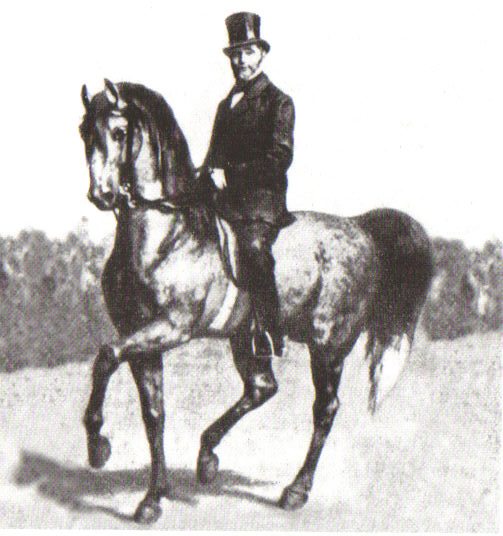
“I must remind the reader again and again to give up old prejudices and to derive the rules for the rider’s position only from natural principles. The unchanging so-called prescribed seat to which many instructors stubbornly adhere is the reason that the art has such a bad reputation. It prevents the student from becoming independent on his horse since with such a seat, he will lack the necessary feeling to be able to correctly evaluate his horse’s carriage and movement. The rider who has been schooled in such a seat will present, after a long struggle, not a thoroughly schooled horse – that is a horse whose natural talents have not only been channelled and made subservient by dressage training but have also been developed by suitable exercises – but a wooden machine which, although working mechanically is devoid of all elasticity and freshness in its way of going. Such horses are certainly not likely to produce enthusiasm for the art because their dull, mechanical way of going fatigues the rider and wears the horse out before its time.”
“For that reason, many riders feel safer and more comfortable on a horse with good conformation that moves in its natural carriage, than on a confused, so-called dressage horse that has been robbed of all its vitality. Whoever does not want to degrade this beautiful art to a mere trade – an art that has been held in high esteem from early times and will continue to be appreciated as long as there is courage and chivalry in the human race – should first be diligent in exercising his own body and making all its parts agile and mobile, so that his stiff limbs will not act as shackles on better understanding and feeling.”
next, riding with one hand or two…
Story continues below the advertisement
While Steinbrecht was very much closer to the modern dressage style than any of his predecessors, there are still a few crucial differences, for instance, horses were still ridden predominantly with one hand, although styles were changing:
“However, guiding a horse with the left hand alone requires a completely trained horse that is capable of responding to the curb only. The old masters, who had time and means for such thorough work, knew only the curb bit for the well-ridden horse and placed their little finger between its two reins. For preparing the green horse, they used the cavesson. Today, since we have once and for all added the bridoon and its two reins to the curb bit, we admit right from the start that we do not intend to, or are not able to, work out horses to such perfection that they can be mastered under all circumstances with only the curb reins in the left hand… Because of the differences in our bits, and primarily the less perfect carriage of our horses, we must also modify the hand aids just as we must adapt our seat to the changed conformation of our present-day horses and to the English saddle.”
Otto Lorke and the beginning of the ‘modern’ style of dressage
By the time of Steinbrecht, dressage is moving away from the fixed outline of the Renaissance horse – even in 1909, this photo of Otto Lörke looks much more ‘modern’ – we will see what a crucial role Lörke played in shaping dressage in the twentieth century. I guess it is because it took so long for a translation of Gymnasium of the Horse to appear in English, that Steinbrecht is largely unquoted in English language equestrian discourse, a pity since his words make far greater sense than some who are more regularly cited.
Consider: “Correct dressage training, is, therefore, a natural gymnastic exercise for the horse, which hardens its strength and supples its limbs. Such exercise causes the strong parts of its body to work harder in favour of the weaker ones. The latter are strengthened by gradual exercise, and hidden forces, held back because of the horse’s natural tendency towards laziness, are thus awakened. The end result is complete harmony in cooperation of the individual limbs with these forces, enabling the horse to continuously and effortlessly perform, with only the slightest aids from the rider, such regular and beautiful movements as it would demonstrate on its own only fleetingly in moments of excitement.”
James Fillis was a controversial figure in the nineteenth century
Steinbrecht was opposed to the unnatural school of Baucher – and to his disciples like James Fillis.
Steinbrecht certainly saw his horsemanship as being natural horsemanship as opposed to the artificiality of the French school of Baucher: “The greatest example of such quackery is Mr Baucher, who with the audacity of his claims and the enormity of his promises, has brought the entire equestrian world into uproar and confusion. His method consists in gradually and cunningly robbing the horse of its natural power, which Mr Baucher considers to be the enemy, and to thus make it subservient. He renders his horses so wilted and limp by unnatural bending and twisting in place and so thoroughly robs their natural forward action, that the poor creatures lose all support and are no longer good for any practical purpose.”
Story continues below the advertisement

François Baucher (1796 – 1873) was a highly controversial figure whose performances could provoke near riots. According to Charles Harris, in his foreward to Hilda Nelson’s François Baucher – The Man and his method:
“Baucher demonstrated (his methods) time and time again throughout his riding life, with dangerous horses destined for the slaughter-house, and upon whom within eight to ten weeks he was giving high-school displays, night after night in the circus. These displays took place before a clamorous public with much of the controversy between opposing factions of the nobility and military on both sides, pro-Baucherists and anti-Baucheristes.”
Baucher is best remembered today for the formulation ‘reins without legs and legs without reins’ but even Baucher came to see this for the nonsense it is, and by the time he articulated his Second Manner had abandoned it. In his famed Q & A session, Baucher is asked: Should the legs and hands act separately, or ought they assist one another? and replies: Each of these aids should be assisted by the other.”
(The Principles of Horsemanship by F. Baucher, 1854, translated from the French by John Swire, page 88)
The idea of legs without etc, only appears for the first time in the 12th Edition of the New Way, primarily because Baucher was anxious to sell his method to the military and this was a good simple method to produce basic walk, trot and canter. For higher work, Baucher made use of the combined effect (indeed he is the pioneer of rolkur with his technique of remaner outré!)
Baucher rode only in the manège, while his opponent, the Comte d’Aure advocated a much more natural style of riding, including riding cross country and over obstacles…
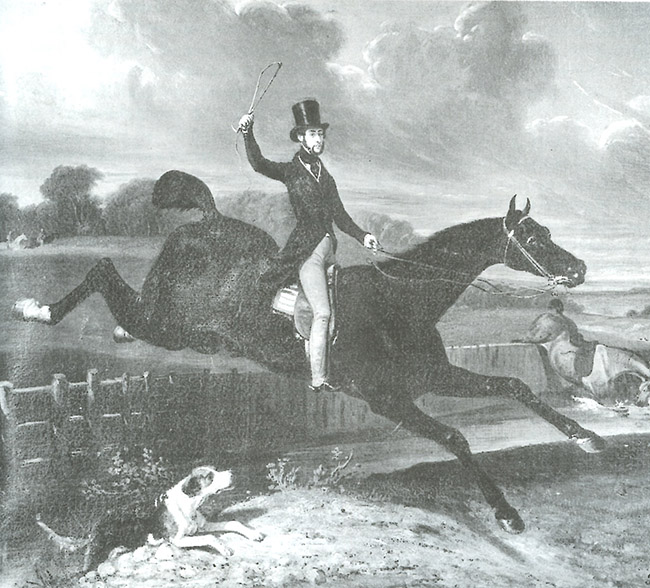
Comte Antoine Cartier d’Aure (1799 – 1863) Master of the Horse to Louis XVIII and Charles X of France, and from 1848 to 1855, civilian chief instructor at Saumur
According to Hilda Nelson: “D’Aure’s type of equitation exemplified the new equitation, exterior… In his Traité d’Equitation, he says that since English equitation is primarily devoted to racing and the hunt, the English consider speed ‘as the most important quality’ and thus, in the training of young horses, they use ‘methods that are the correct ones to push them forward’. D’Aure’s own method can be summarized as going ‘forward! always forward!’. This slogan is the opposite of that of Baucher. While both Baucher and d’Aure stressed balance and considered impulsion as important in the horse’s rhythmical and free forward movement, Baucher’s aim was total control and complete balance of the horse. D’Aure’s aim was impulsion and directness, for he wanted to use the horse’s natural movements and avoid any prolonged constraints on the horse hose, Instead of producing an artificial andd toal balance, d’Aure wanted to produce a natural balance.”

Baucher – for a stimulating discussion on the integration of the teachings of Baucher
AND la Guérinière, see Miguel Tavora’s article here
It is Steinbrecht that we are well advised to return to after the artificiality of the Baucher School. Again and again, he stressed the NATURAL basis of his principles, the principles that became the modern training scale:
“If I have pointed out in these general comments the difficulties involved in the natural training of the riding horse on a scientific basis, this was not done to frighten amateurs away from the more serious studies of the art, but rather to motivate them from such studies. With a correct view of the principles of this art, it is quite possible to find a way to the desired goal by independent endeavours. Our generation is neither lacking chivalrous spirit nor in talent, nor in the means to return this beautiful art to its highest flourish…”
“The first prerequisite for reawakening a general interest in the art of riding and a contribution in this respect is the main reason for writing this book is to ban from the art everything that is stiff, forced, and pedantic and to overcome the prejudices that a man on a horse must carry himself in strange posture, and that the dressage horse has to walk around as if screwed into an instrument of torture. Instead, the equestrian art is for both the type of natural gymnastic exercise with which it is possible to attain and demonstrate the highest development of physical strength and skill.”
This passage would seem to me to encapsulate what is important about the Classical Tradition, and with Steinbrecht, the connection between the horse’s natural physical and mental properties and the methods and aims of dressage training – only hinted at in previous texts – is made explicit. This does not mean that Steinbrecht, any more than any of the previous writer / horsemen, has ‘the last word’ on the subject, since obviously, as Steinbrecht himself stressed, changes in the breeding and the conformation of the horses, will produce further changes and refinements.
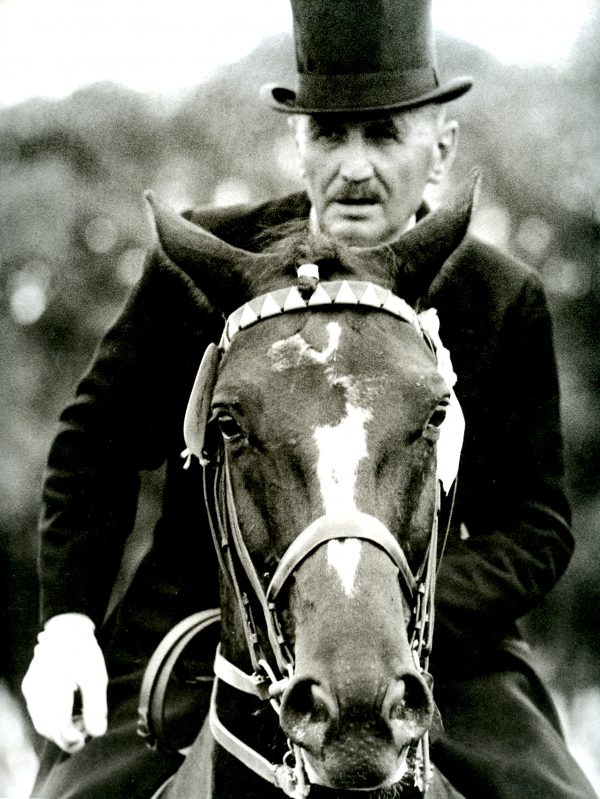
The trainer that influenced so many Twentieth Century Trainers:
Otto Lörke
The end of the nineteenth century also saw the birth of one of the most influential figures in modern German dressage, Otto Lörke. He was born in 1879, and died in 1957. Colonel R. A. Abé penned this tribute for the 1959 edition of L’Annee Hippique.
Richard Abé was born 1898 and in the 1920s and 30s, he was a successful rider in various disciplines. After the Second World War he was the long time chief editor of the German Horse Sport and Breeding Magazine St-Georg and one of the most important dressage judges of Germany. One of his successors, Jan Tönjes tells me that Abé published his judge’s notes from the Aachen score sheets in St. GEORG while he was editor-in-chief. Neckermann put pressure on the FN to enter in the rules that a ‘journalist from St. GEORG’ (sic!) wouldn’t be allowed to become an international dressage judge.
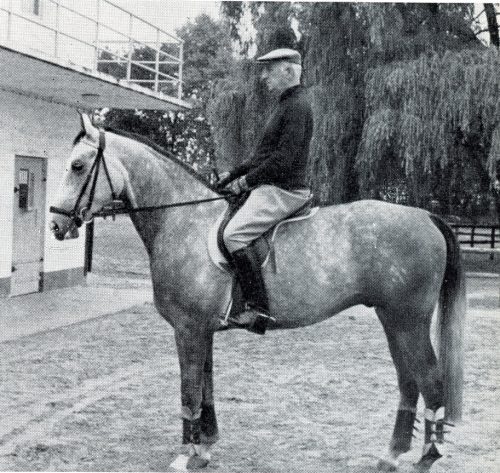
Abé didn’t just judge and write, here he is riding a four year old at Aachen
Here is Abé’s tribute to Lörke:
Otto Lörke’s death meant a great loss to horsemen almost everywhere. In the fifty years of his riding activities, he not only won countless competitions in the saddle but the number of well known Dressage winners he produced has surpassed anything we have seen in our time. Furthermore, he not only trained those horses, but also ‘made’ the riders who won with them. The work of his life really is a chapter in the history of the classic art of equitation.
Lörke, as Gustav Rau has put it, was a born genius, and as such was able to do away with the rules and limits that have to be observed by the average horseman. He had learnt, it is true, the military system of riding when he was serving his time with a Ulan Regiment of the Royal Prussian Guards. However, his great successes later on were mainly due to his own way of riding and training. During Lörke’s service in the army, his ability was soon discovered by his superiors, and he worked together with the then Colonel Baron Holzing-Berstett – who later became President of the FEI – and Count Lubert Westphalen. Lörke afterwards was transferred to the Royal Stables in Berlin where he was appointed the Kaiser’s ‘Leibund Sattlmeister’. His ability to produce supple and obedient horses that could be ridden by anybody was soon recognized.
Therefore he was given the task of preparing the Kaiser’s horses, which had to be particularly well-trained as the Kaiser was hampered by a shortness and weakness of his right arm.
After the 1918 revolution Lörke, went to the Preten-Stud for a short time before establishing his own stables in Berlin. In those years that mark the growing popularity of showing and showjumping, he made his name as a specialist in dressage with Alberich, Diamant, later Pommerländer, Stracchhur, Dorffrieden, Fanal, to mention only a few. They all distinguished themselves by great impulsion and action; Lörke did not like ‘bores’ be it horses or men.
In the late twenties Lörke had so many well trained hoses in his stables that he was able to mount eight former Generals, who performed the famous Quadrille at the big Berlin Indoor Horse Show, that was watched by the President of the Reich, Field-Marshall von Hindenburg.
Some years before the Olympic Games of 1936 he was asked to go to Hanover Cavalry School to train horses and riders for the Grand Prix de Dressage. The result is known. The German team consisting of Major Gerhard – Absinth, Captain von Oppeln-Bronikowski – Gimpel and 1st Lt. Pollay – Kronos won the Gold Medal, the last named combination also winning the Gold Medal for the best individual performance. The commandant of the famous Saumur Cadre-Noir, Commandant Lesage, afterwards rode Kronos in Berlin. He said, never in his life had he been on a better-trained horse.
During the trying times immediately after the second world war, Lörke and his horses found a new home at Vornholz through the kindness of Clemens von Nagel-Doornick, who not only tried to collect what was left of outstanding German riders, but also made contacts again with horsemen from foreign countries. Here, Lörke produced a new string of great dressage horses Chronist, Lodi, Pernod, Afrika and Cyrenaika that were later joined by Adular and Malteser. We are glad to remember the pleasant demonstrations he gave together with his able pupils, Baroness Ida von Nagel, W. Schultheis and W. Schönwald at numerous shows. There is nobody who knew better than Lörke how to keep dressage horses at the peak of their form, and fresh, up to their old age, the huge East-Prussian Fanal, now 23 years old, being an example.
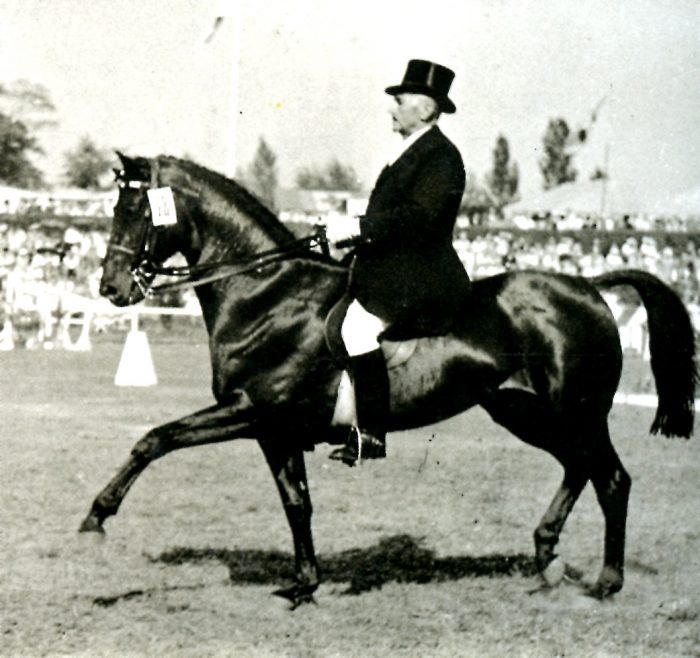
Riding the great, Chronist
Twice again the great instructor shone at the Olympic Games to demonstrate the classic art of equitation: in Helsinki 1952 and Stockholm 1956. Here is what Gustav Rau wrote after Helsinki in the St-Georg Almanac: ‘Our method of riding was well represented. The three horses were really supple, they definitely were in that high collection which is indispensible to do the difficult figures of the Grand Prix de Dressage correctly and cleanly. Impulsion in the extended paces could not have been better. Adular was brilliant and, even in the most difficult figures, did not hesitate to obey his rider’s aids. Herr O. Lörke had got horses and riders ready to give an admirable demonstration before so many critics.’
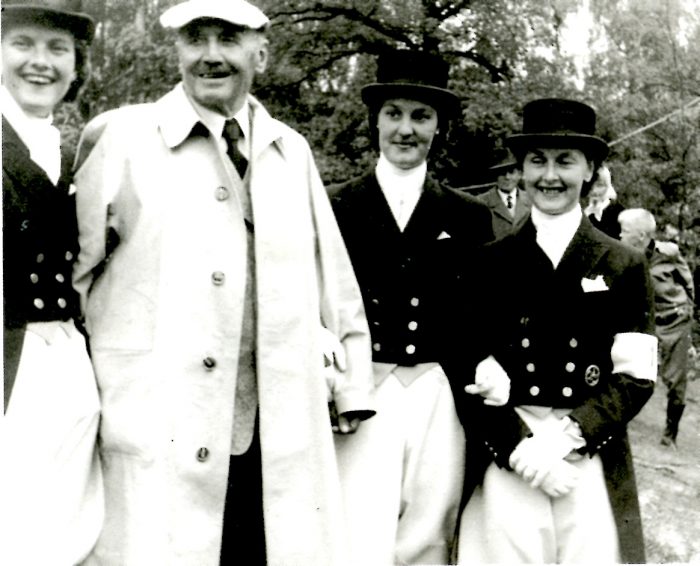
Lörke with his team at the 1956 Games – Liselott Linsenhoff, Anneliese Küppers
and Hannalor Weygand
Thank you Richard Abé
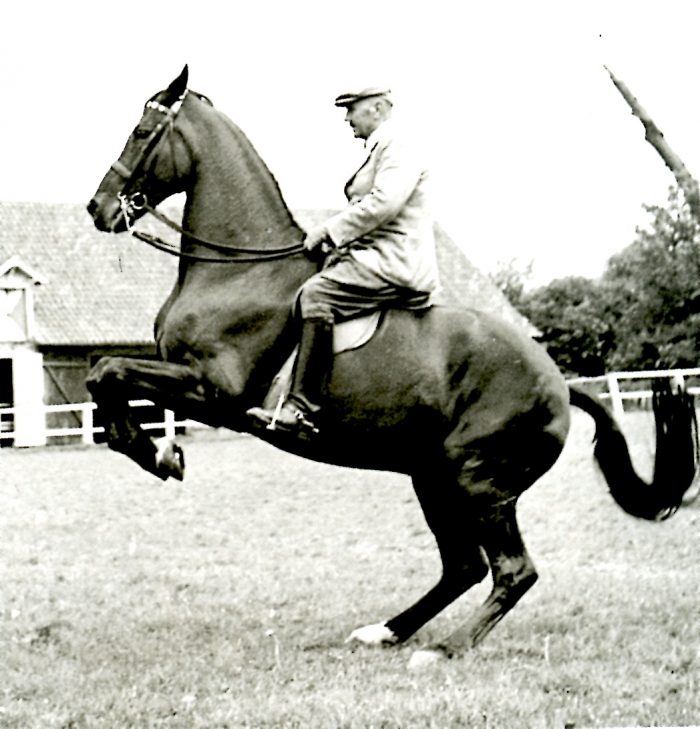
Lörke and Fanal
The line of Lörke’s influence extends. One Lörke pupil was Bubi Günther (1921 – 1974) who in turn trained Herbert Rehbein (1946 – 1997) who trained scores of German and International students during his time at Grönwoldhof. Another Lörke student was Herbert Kuckluck trainer of, amongst many others, Ann-Kathrin Linsenhoff. Kuckluck trained Siegfried ‘Bimbo’ Peilicke (1932 – 2012), who from his base in Warendorf trained riders all around the world. Then the last of our trio of Lörke students, Willi Schultheis (1922 – 1995), another hugely influential figure, and trainer of Rudolf Zeilinger, formerly the Danish team coach, now coaching Spain.
Lörke was rumoured to carry a small pen knife in his pocket and when-ever he saw draw reins cut them into small pieces. Although he never wrote a book, he told his pupils to ‘look at me and try to discover the art yourself.’
In the next and final instalment in this series, we look at where dressage is today…
The Classical Tradition, the Training Scale and Dressage Today
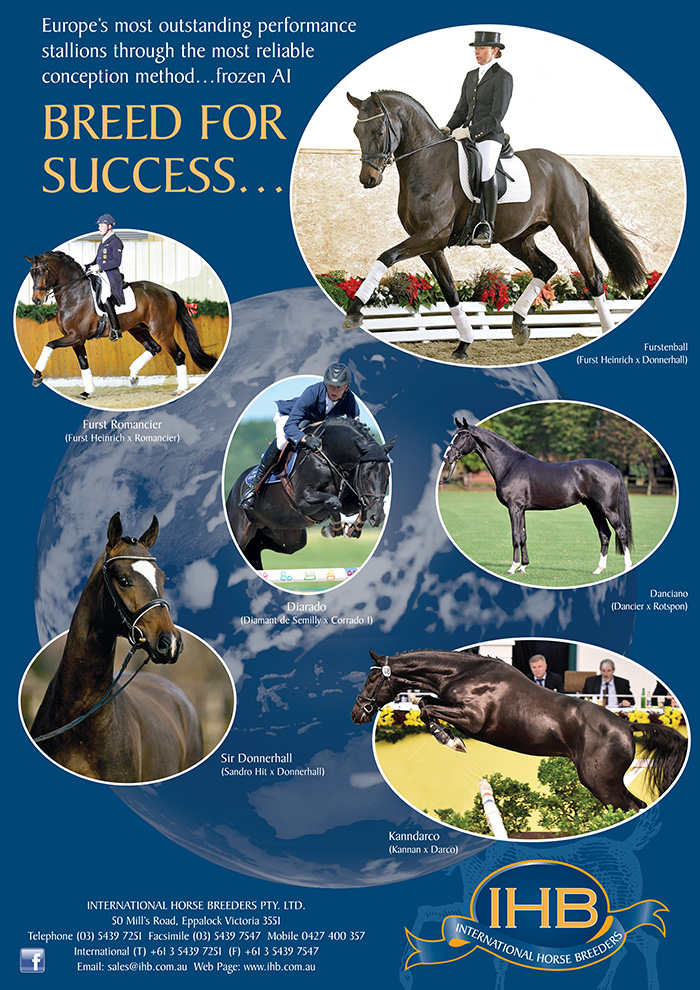

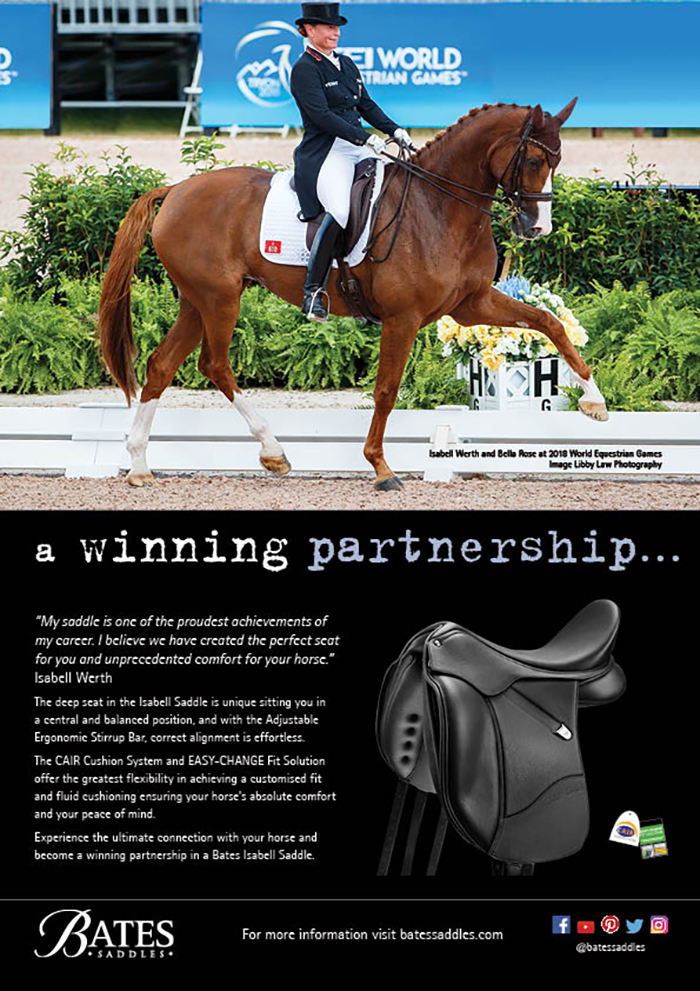
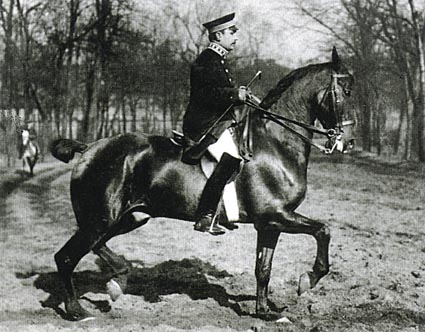
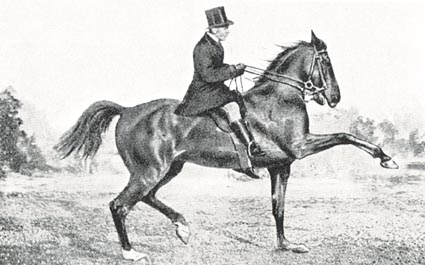
I have been ‘going on’ for year at multiple Dressage Clinic in South Australia about the importance of horses being allowed to carry their heads and necks in the naturally designed manner that supports the horse’s well-being PLUS which shows correct or ‘proper’ outcome of Dressage Training has been achieved…so was SO good to see the many good pictures/drawings of ‘good’ Dressage riders/their horses who were promoted in the last three articles in this series which shows how the Dressage horse has been trained in the past to be able to to perform dressage ‘movements’ in this ‘healthy’ type of correct carriage….but it’s up to the judges of Dressage to ‘lift their game’ regarding the judging of the horse’s carriage in Dressage tests before the mainstream Modern Day Dressage Horse will be able to trained in the way that supports its welfare i.e. as these past Masters were able to do…BUT then we need to have Modern Day Dressage Coaches/Trainers who have the ‘know how’ to ensure that horses can be trained appropriately i.e. for their welfare in this Sport.
I have really enjoyed this series of articles on the history of dressage and the finer points. Will Chris’s articles ever be assembled into a book. They are such interesting and insightful reads and I think they should be on every riders shelf.